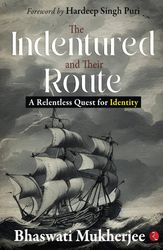Forty years ago, I was doing a master’s course at the University of Leeds. A couple of my good friends were from Pakistan. We noticed that almost every third person on Oxford Street and Piccadilly was a person of colour, with a preponderance of South Asians. A Pakistani friend―a Pathan with a great sense of humour―joked about the few white men we saw, “Humne Hindustan, Pakistan se inhe bhaga diya, ab englistan se bhi bhagayenge [We drove them out of Hindustan and Pakistan, now we shall drive them out of England].” We did not drive anyone out; instead, we assimilated, learnt from them and taught them.
Former diplomat Bhaswati Mukherjee, in her fourth book, The Indentured and their Route: A Relentless Quest for Identity, tells the poignant story of indentured labour from India, forced to go to the West Indies, Mauritius, Suriname, Reunion and Fiji islands as a consequence of famine and poverty, a harsh foreign regime in India and alluring promises that never materialised. This story is a work of great scholarship, based on a study of multiple books and documents.
From 1834 to 1917, 1.3 million Indians left as indentured labour. Only 21 per cent returned; the rest either died or settled in the lands of their forced exile. Two factors contributed to the growth of indentured labour. One, the end of the Mughal empire and the rise of British colonialism brought about a big change in the living conditions in the subcontinent. While the Mughals were conscious of the conditions of the peasantry, and adopted administrative systems that were sensitive to their needs, the British and other European colonial powers exploited their colony for the enrichment of their distant homeland. They raised revenue shares to about 60 per cent. Millions of famine deaths occurred, yet the exploitation continued relentlessly.
Two, the movement against slavery threatened the supply of cheap labour to the plantations. The indenture system was a kind of agreement with the helpless and illiterate labour force, called girmit in its Indianised form, thus leading to the expression ‘girmitiyas’ for indentured labour. Middlemen promised girmitiyas relief from abject poverty, and obtained their thumb impressions and herded them into ships, with paltry rations. On the way, many died of cholera and smallpox. The planters, however, found that their slaves had been replaced by even cheaper labour. “One of the first planters to employ indenture confided in 1835 to an associate that ‘their cost is half that of a slave’,” writes Mukherjee.
While girmitiyas were initially men, women soon joined them. The arrival of women and the formation of families changed the character of indenture. They became productive workers, rather than exploited labour. A political movement against indenture also emerged, supported by Mahatma Gandhi and leaders of the Indian National Congress.
Generations later, descendants of the girmitiyas were fully assimilated into the culture and politics of the foreign lands. Their influence and position in society varied from place to place, strong in Mauritius and weak in Fiji. Yet, they retained their affinity towards India, as did India with them. UNESCO’s Indentured Labour Route Project, initiated by Africa and led by Mauritius, was strongly supported by India. The UNESCO recognised Aapravasi Ghat and Le Morne Cultural Landscape in Mauritius as world heritage sites.
Overall, a tragic, compelling story with a happy ending, told with empathy and skill.
Chandrasekhar is former Union cabinet secretary.
THE INDENTURED AND THEIR ROUTE: A RELENTLESS QUEST FOR IDENTITY
Author: Bhaswati Mukherjee
Publisher: Rupa Publications India
Pages: 232; price: Rs595


